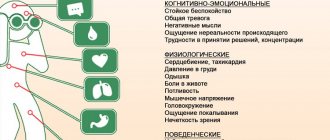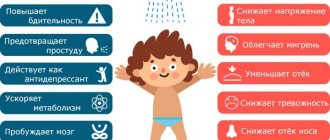When does a panic attack occur?
The mechanism of panic paroxysm is based primarily on the psychological factor, and the vegetative one is considered secondary. During an attack, there is an increase in the negative emotional background for 10–15 minutes, then a gradual decline. The provoking trigger is three factors, together or one at a time:
- psychogenic - conflicts and personal tragedies, as well as abstract factors of an informational nature;
- physiogenic - taking certain pharmacological drugs, steroids, alcohol, drugs, weather changes, overexertion, prolonged exposure to the sun, acclimatization);
- biological - fluctuations in hormones due to pregnancy, menstruation, abortion, childbirth, menopause, the onset of sexual activity, and the use of contraceptives.
The diagnosis is made if the attack recurs at least twice in the presence of several signs.
Vegetative symptoms include:
- sweating;
- feeling of a lump in the throat;
- a sharp rise in blood pressure;
- heartbeat;
- dry mouth;
- heat;
- chills;
- nausea;
- diarrhea.
From psychological:
- thoughts of approaching death, fear of dying;
- derealization;
- feeling of loss of self;
- dizziness, etc.
PA during menstruation: causes of occurrence
In women of fertile age, menstruation and panic attacks are closely related, and panic attacks are considered a typical, common, although not inevitable, manifestation of PMS. Let's consider the main manifestations of this disease.
Panic attacks before menstruation
The disorder is common mainly among female residents of megacities aged 25 to 45 years. Panic attacks before menstruation are more pronounced and occur with greater frequency. During this period, a woman experiences strong emotional stress and is prone to impulsive actions. Medicine considers the occurrence of attacks against this background as the result of hormonal fluctuations.
The patient may search for the reason for the recurrence of attacks for quite a long time. At the same time, the tests are normal, there are no serious pathologies, but every time the “red days of the calendar” approach, the attacks are repeated. And if panic usually results from stressful situations, then before menstruation it occurs for no apparent reason. A woman can be overcome by a wave of groundless fear, even when she is at work, among familiar people, performing her usual duties. And at a young age, this condition is especially difficult to cope with, since girls have not yet developed full adaptation to their living space.
Important! The insidiousness of panic disorder when menstruation approaches is also the fear of recurrence. Against the background of PMS, a panic attack anticipation syndrome is formed. The disturbing memory of the emotional state intensifies as it approaches the beginning of menstruation and naturally causes a repetition of the attack of fear. The connection between the attack and menstruation becomes inextricable, and the woman’s fears for her health intensify.
Panic attacks during menstruation
In the first half of the cycle, women's estrogen levels increase, and in the second - progesterone. These fluctuations are physiological and are aimed at cleansing the uterus to prepare it for a possible pregnancy. A woman experiences panic attacks during menstruation much more acutely, since the imbalance of the autonomic system increases due to the change in phases of the cycle, and the production of the joy hormone, endorphin, decreases.
Symptoms of a panic attack during menstruation may include mood swings, feelings of despair, increased pain in the lower abdomen, and severe headaches.
Sometimes, due to regular panic attacks before menstruation, agoraphobia develops - the fear of being in public. This is more likely to happen if attacks are repeated in crowded places, as there is a subconscious connection between panic and large crowds of people.
How to fight on your own
In any case, you can also try to cope with the disease on your own. There are various practices and techniques for this, including meditation.
Know the “enemy” by sight
It is recommended that in a calm situation in a convenient location, you remember all your existing fears. It is advisable to write them on a piece of paper and next to it determine the likelihood that this could happen again. If the percentage is high, then you just need to play it safe and take measures to protect yourself.
If a loved one has an attack
In the event that a panic attack begins to occur in front of your eyes with a loved one or acquaintance, you should maintain a calm state of mind. Self-confidence will help make sure that everything will be resolved, there is nothing scary or dangerous. It is advisable to take the panicked person’s hands or hug him at the time of the attack, and talk to him in a calm, even voice on a pleasant and relaxing topic.
Bracelet technique
For women prone to panic attacks, psychologists recommend constantly wearing a rubber bracelet on their arm. Today it is not difficult to find a similar accessory that will complement the wardrobe of even the most sophisticated fashionista. As soon as the girl realizes that she is starting to “storm,” she should tighten the elastic band of the bracelet so that it hits the skin of her wrist. The click that she hears at this moment will be like a signal to switch to real reality. This technique helps you concentrate on what is happening, and not on some unpleasant situation from the past.
Switching technique
At the first signs of a panic attack, you need to “pull yourself together” and try to concentrate your attention on something else - on passing traffic, start counting down, repeat a poem, talk with someone on an abstract topic. Once the brain is redirected, the panic attack will pass.
A similar technique is used when mastering auto-training. In this case, you need to convince yourself, repeating, that the attack is passing, everything is fine, the situation is completely different, etc.
Breathing techniques
In most cases, during an attack, a woman finds it difficult to breathe. If you learn to cope with this, then panic will be easy to overcome. It is important to master the technique of smooth, calm breathing.
Relaxing tea
Many women find it helpful to cope with less frequent attacks by regularly drinking sedatives at night. As a rule, it is some kind of tea. Drinks based on chamomile or oldflower infusion are popular. A cup of hot tea in a calm and cozy environment will bring a feeling of calm and security.
Relaxing music
It has long been noted that people react to sounds differently. It is used in medicine – music therapy. Commonly accepted relaxing melodies are the sounds of nature: the sound of rain, sea, forest or birdsong. The music of Vivaldi and Beethoven also has a positive effect on women prone to panic attacks. Psychologists recommend listening to pleasant notes at least twice a day, with an obligatory evening session.
Panic attacks are a fairly common pathology. The greater susceptibility of women to this disease is due to many factors: social workload, impressionability, susceptibility to influence. It is known that panic attacks occur more often during menstruation, the reasons for this are explained by changing hormonal levels these days. Self-training in various relaxing techniques, music therapy and some other methods will help you learn to cope with such situations. But to be on the safe side, it is better to seek help from a specialist.
Similar articles
- Menstruation with VSD, exacerbation of pathology before or during...
Sometimes it is very difficult to understand where premenstrual syndrome is, where VSD is during menstruation, and when it is panic attacks. Read more - Hot flashes during menstruation: causes of fever...
Vegetative crises are accompanied by a feeling of lack of air, various panic attacks, pulsation of blood vessels throughout the body is felt, etc... Read more
- Tearfulness during menstruation, before, after: why...
Panic attacks during menstruation, before it: reasons... Read more
- Menopause and VSD: causes of the disease, manifestations...
Panic attacks during menstruation, before them: reasons... Menstruation with VSD, exacerbation of pathology before or during... Read more
- Is there a relationship between menstruation and heart pain?
Panic attacks during menstruation, before it: reasons... Read more
- Medications for menopause against hot flashes: hormonal…
Do breathing exercises. It will help restore your heart rhythm, relieve anxiety, and prevent a panic attack. Read more
PA before menstruation: what to do
This condition is not life-threatening, but it greatly poisons existence. You can cope with the first signs of growing panic in logical ways.
The first step, when you feel that panic is clouding your mind, is to take control of your breathing and calm your heartbeat. After taking a deep breath, hold your breath and exhale slowly. You can also breathe into folded palms or a bag, while breathing with your stomach. This technique is aimed at saturating the blood with carbon dioxide, which suppresses the release of the hormone cortisol, which is responsible for sudden stress. Sometimes these actions are enough to capture the onset of an attack, block panic and prevent it from developing.
Panic attacks during PMS develop against the background of emotional instability caused by hormonal changes. This condition can be dealt with by switching the brain to perform some action. Remember, for example, the multiplication table, read words backwards, perform other actions in your mind. In a few minutes you will be convinced that the world around you is not collapsing and nothing terrible is happening.
Buy a rubber bracelet or weave one yourself from colored rubber bands and put it on your wrist. At the first sign of panic, pull back the rubber band and let go. A flick on the wrist will help you come to your senses and come to your senses a little.
A week before the start of your period, give up eating meat and include soothing herbal teas in your diet. This will reduce the production of cortisol by the endocrine system.
Do yoga. This ancient technique is aimed not only at achieving body beauty, but also mental clarity. Combine yoga with meditation practice. You will soon notice that panic attacks during PMS become less frequent and weaker.
In the video below you can see other ways to get rid of seizures:
Panic attacks during menopause: symptoms and treatment
Characteristic signs of hormone deficiency during menopause may resemble manifestations of a panic attack: a woman is seized with fever and chills, her heart rate increases, outbursts of irritability and headache appear. One can be distinguished from one another only by a feeling of strong all-encompassing fear or causeless anxiety.
In general, every sixth woman suffers from panic attacks during menopause. The following factors can trigger an attack:
- smoking and drinking;
- constant stress and emotional overload;
- lack of sleep;
- physical exercise;
- inability to express emotions.
The number and intensity of panic attacks during menopause can be aggravated in the presence of such disorders as:
- obsessive-compulsive disorder;
- post-traumatic disorders;
- cardiovascular pathologies;
- emphysema;
- migraine;
- thyroid diseases;
- disruptions in the functioning of the adrenal glands;
- allergies of any origin.
Treatment of panic attacks during menopause includes hormonal therapy under the supervision of a doctor; the above recommendations for blocking the first signs of panic will also be useful.
Important! You cannot prescribe hormonal drugs on your own - the consequences can be unpredictable.
Types of PMS
For each woman, the precursors of menstruation manifest themselves individually, taking into account genetic predispositions and characteristics of the body. The following types of PMS are distinguished.
Neuropsychic change
Destabilization of the emotional state is expressed by unmotivated aggression, depressed state and excessive resentment. Changes occur in the central nervous system.
The appearance of edema
Edema manifestations are associated with fluid retention in a woman’s body during the luteal phase of the menstrual cycle. Before menstruation, the legs and face swell, and itching may occur. It is these menstrual symptoms that provoke swelling of the mammary glands.
Neurological or cephalgic disturbances
These changes are characterized by headaches, attacks of nausea or vomiting. I often feel dizzy before my period.
Crisis manifestations
Crisis manifestations intensify in women before menopause. Sympathoadrenal crises often occur, which are accompanied by an abnormal heart rhythm and increased blood pressure.
Mixed manifestations
This is a combination of several types of PMS at the same time. The edematous form is complemented by an unstable emotional state.
Atypical manifestations are rare
In this case, atypical symptoms are combined: suffocation and migraine, allergic reaction and vomiting.











